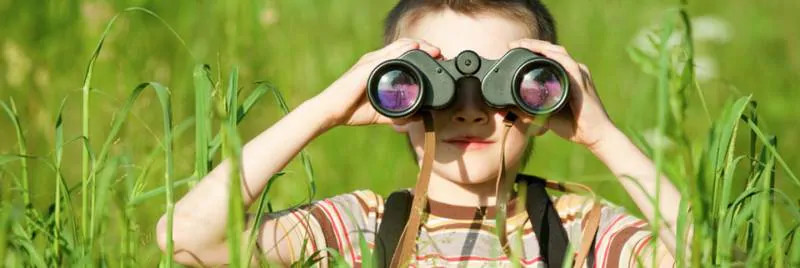If you’ve ever seen the smiles on children’s faces when a kids’ treasure hunt has been announced, you’ll know that this fun activity is well worth the time and energy you put into organising and dismantling it. Kids love getting out and about, discovering new things, exploring, and using their powers of deduction – and the best kind of mess and dirt is picked up by kids having fun!
Here’s an easy-to-follow guide to planning great treasure hunts for kids – and don't forget to download our special clue templates for treasure hunts! They are sure to make your treasure hunt extra special. And don't worry about any stains your little ones pick up along the way, check out our tips on how to use laundry capsules to remove stains, like mud and grass.
1. Choose a location for your treasure hunt for kids
Before you even start thinking about treasure hunt clues for kids, or an end prize, you need to know how many kids will be participating in the hunt, and their ages. This makes it easy to select an appropriate place for the game to take place. You might consider holding your treasure hunt in the following places:
At home.
Simple treasure hunts for a few young children can be set up in your home. Indoor treasure hunts for kids make a fun rainy day activity, and work well as part of a small, indoor birthday party for younger children.
In gardens or parks.
This works well with larger groups of children, either working together or in teams. Great as part of a nature-themed trail, Easter egg hunt, or as an outdoor birthday game.
At museums or art galleries.
These make amazing locations for themed treasure hunts for kids over the age of six. Many museums and galleries already have organized trails or treasure hunts for children; you can check online before you arrive to be sure.
Throughout your neighbourhood.
This is a great way to explore the local area. Map or trail-based treasure hunt clues for kids can even use local landmarks as reference points. Just make sure your kids are aware of the proper road safety precautions and other urban safety requirements before you start.
2. Choose a theme and format for your kid's treasure hunt
If you’re organising a treasure hunt for a birthday party, you’ll want to match your hunt to the party’s theme. A classic treasure hunt for kids suits a pirate theme, of course – but the format can be adapted to fit almost any party motif. Here are some treasure hunt ideas for kids you might like to try:
Pirates.
Give each team a treasure map with the general location of the clues marked on it (No. 1 in the bedroom, No. 2 in the kitchen, and so on). Each clue will have more specific information as to the location of the next one. For example, while the map indicates a room or an area of the park, or museum, and so on, the clue could specify the object: “I’m blue and I’m round and I have water inside” – a vase. Teams race to find where “X marks the spot” – chocolate gold coins and candy necklaces make convincing pirate treasure.
Detectives.
A robber has broken into a safe and stolen some valuable jewels! The prize could be a bag of mixed sweets – choose treats that look like gemstones for an extra-realistic touch. The kids must find the clues to unlock the mystery and discover where the thief has hidden his loot.
Aliens.
A group of extra-terrestrials have landed on earth, and have been leaving strange objects in odd places. Players must collect them all to spell out the location of the space ship and the prize that awaits them.
Ancient Egypt.
Discover the lost treasure of the pharaohs by unveiling the location of ancient scrolls and deciphering the hieroglyphics! A combination of treats and jewellery made from foil or gold craft paper makes an excellent prize.
Magical Kingdom.
The aim of this hunt is to collect enchanted talismans (jigsaw pieces) that, when put together, will direct players towards a magical reward! You could even use a hole punch to make each jigsaw piece into a necklace players can take home as a souvenir.
Football Competition.
Kids work in teams and use their footy skills and knowledge to earn clues – small sports challenges along the way make this kind of hunt unique! Place clues at the end of small assault courses, or set it up so kids earn clues by scoring a goal, successfully heading a ball, or dribbling it around cones. The clues lead to a final play off for a big competition.
Destination Unknown.
Players follow ‘blind’ directions (for example, “Walk to the bottom of the road and turn right”) to an exciting mystery location – a picnic lunch, cake shop, or ice-cream stall are all fun destinations.
3. Decide where you will hide your treasure, and work backwards
Every child wants to be a winner, so make sure you also have a selection of smaller prizes on hand for runners up, or offer one big prize that can be shared by a group. Decide where you are going to hide the treasure, and then design your clues leading away from that place – it’s easier to plan hunts backwards. Consider writing yourself a crib sheet of locations, so that you know where you’ve hidden all the clues.
4. Create your kids' treasure hunt clues
Persil has put together some great clue templates for treasure hunts that you can use – just print them off and fill them in! When you’re putting together your clues, remember that kids will get tired quickly if they’re too hard. Treasure hunt clues for kids don’t need to be complicated. In fact, for non-readers pictures can work as hints instead; and for those just learning to read, simple words like “Fridge” might be a challenge in themselves!
An educational treasure hunt for children who are still learning literacy could involve threading a ball of string through the house to connect letters, eventually spelling out the location of the prize. For older children, make clues fun using rhymes or riddles. For example:
If I had three legs, I wouldn’t be stable. I’m where you eat breakfast, I am a…(Table)
If you’re doing a themed hunt, create clues to match. For example, if the theme is fairy tales, you could lead to a clue written on a mirror by writing:
“Your journey’s only just begun, The prize is far ahead, An evil step-mum looked at me, But saw Snow White instead!”
You might prefer to give clues on a hand out, or make treasure maps for kids instead – but remember to keep everything age-appropriate. The more detail you put on a treasure map, for example, the more confusing it could be for a younger child. At the same time, older children enjoy more of a challenge, like games that are rewarded with clues, or unveiling parts of a greater mystery.
5. Do a final treasure hunt run-through
Before you start the hunt for real, double check that all the clues (or activities) are where you left them, and that they lead to each other in the right way. Make sure the hunt doesn’t take too long – reduce the number of clues if you think this will be the case. Finally, make sure you have adults on hand to keep everyone going in the right direction.
For more themes and ideas on planning your treasure hunt, just keep reading!
Get those tricky mud stains out of clothes after hunting for all that treasure with Cleanipedia's article.


